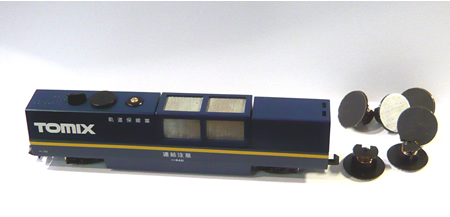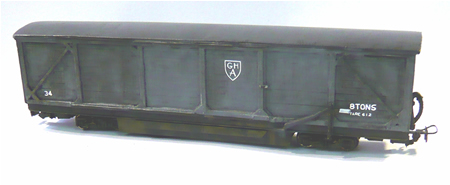|
keeping your model railway clean
After having spent a great deal of time
building your layout, the next problem you will have is to keep it clean.
A customer once complained to Ettore Bugatti that the car he had supplied
did not start easily in the mornings. Bugatti relied that all his cars
should be kept in centrally heated garages!
By rights, your model should be stored in
what is in effect a 'clean room'; humidity and temperature controlled with
dust extraction. The problem is that unless we dressed up in 'Noddy
suits', even that would not work as humans are constantly shedding their
skin and this amounts to much of our house dust.

If you are able to cover the layout when not
in use, deterioration will be slowed down. Be careful not to damage
anything with a cover, which should never touch any of the scenery.
If you exhibit your layout, you are
completely sunk as thousands will shed their skin all over it! Bit by bit
the colour becomes a little grey and the whole affair will lose its
freshness. Now, PROVIDED that you have ensured that all paper products on
your layout (such as posters and signs) have been properly sealed with
matt varnish, you can carefully use a mister with distilled water and give
the layout a spring clean. Things will mostly return to their original
freshness.
Dust free floors are essential in my view. I
use floor paint on the concrete surface where County Gate is kept and
this helps considerably.

our
workshop during the build of Cliffhanger
County Gate is kept in a converted
barn/garage. The walls and ceilings are lined in foil backed plaster
board and the floor is painted. It is well lit using 8ft tubes and a
dehumidifier is installed which clicks on and off if humidity builds up.
Two wall heaters also prevent freezing during the winter months.
Keeping the track really clean is the bugbear
of all small model railways.
Once the track has been painted and
ballasted, a lot of care is needed to remove any ballast that will foul
the wheel flanges. The scenic work is also very messy and considerable
effort is needed to remove debris and spray products from the rail tops.
For this we used a Peco track rubber which was pushed around with a 2
prong fork, to keep hands away from the delicate scenery. (Don't use your
wife's silverware for this if you wish to live long and prosper)
Continued maintenance is needed and the track
rubber leaves shiny debris on the track and scenery gets damaged nearly
every time.
Our first attempt to find a viable
alternative was a conversion of some American device which claimed
wonders. In a nutshell, a brass drum is wrapped in a bit of dishcloth and
soaked in track cleaner. This is supposed to rotate, dragging slightly and
clean the rails. The thing just derailed. I tried weighting it further and
it just derailed some more. In short, it was as useless as a
chocolate teapot.

At last the Japanese came to our aid!

We sold the BMW and purchased a Tomix 6421
track cleaner. We have fitted
a Digitrax 123 chip to operate the motor. There is a mini vacuum cleaner,
debris being deposited in the centre collector. It will suck up loose bits
of ballast if running flat out. There is also a sprung loaded rotating
wheel which can be operated as a dry polisher or wet, cleaner can be added
to a reservoir. We find the wet cleaner a bit useless, but the dry cleaner
is perfect! In the UK, the track cleaner is now available from Dapol.
It is not powered itself for running. I
wonder if it is that effective on DC as delivered power would depend on
the tow loco speed but on DCC it will run to full capacity.

as it comes
- click on image to enlarge

The boxcar cover
for the Tomix in Glenthorne Harbour Authority livery. - click on image to
enlarge
A word about
SPIDERS. Generally, these
creatures do not bother me too much; at least in the UK where they are not
harmful to humans. When it comes to County Gate, however, we have a very
different story. We have spent hours removing their handiwork with fine
sable brushes and still miss a few. After some days, the first train
through the tunnels will always reappear covered in cobwebs. It was all a
bit like Indiana Jones and the temple of doom!

It was time to go to war! A quick Google and
a company called the
Pest Control Shop came up. They suggested that I use a combination of
water based spray (which is also residual) and ultrasonic devices. The
spray is quite horrible but if sprayed last thing at night has dispersed
by morning. Since then, no more cobwebs have appeared. Another problem
solved!
This is what the blurb says about the ultra
sonic devices:
"Strikeback Ultrasonic Pest Repellers use
advanced ultrasonic sound technology to emit sound waves which are outside
the hearing range of humans, but which many rodent and insect pests are
sensitive to, creating an environment that pests would rather not be in.
With a very impressive sound output of 115dB, the Strikeback Ultrasonic
Pest Repellers have been designed to operate silently, unlike some pest
repellers which can emit an annoying clicking sound. Furthermore, the
frequency output fluctuates between 30kHz and 70kHz, rather than being
static or limited in range, helping to prevent the rodent and insect pests
getting used to the pest repeller.
As ultrasonic sound waves cannot travel through solid objects, it is best
to use one Strikeback Ultrasonic Only Pest Repeller in each average sized
room that you wish to protect.
Please note that all forms of pest control take variable amounts of time
to be effective.
Has no effect on cats, dogs or fish, but will affect pet rodents if they
are in a room where a repeller is plugged in."
So there you have it. Don't share the model
railway room with your pet rat Roland.

|